Tsoulfanidis N. Measurement and detection of radiation
Подождите немного. Документ загружается.


548
MEASUREMENT
AND
DETECTION
OF
RADIATION
where
G
is the total number of energy groups and
Q,
is the average quality
factor for group
g.
In principle, Eqs.
16.7
and
16.8
are valid for any charged-par-
ticle flux that hits a human body from the outside. In practice, for the particles
and energies considered here, these equations are useful for electron and beta
beams only, since alphas with
E
<
10
MeV do not penetrate the human skin.
The dose from external beams of betas will be confined to a depth in tissue
equal to the range of these particles.
The division between electrons and betas is necessary (although beta
particles are electrons) because an electron beam consists of monoenergetic
electrons; a beam of beta particles consists of electrons emitted by the beta
decay of a nucleus. Therefore, as explained in Chap.
3,
these particles have an
energy spectrum with a maximum energy
Emax
and an average energy
1/3~,,,.+
To calculate the dose rate from an electron or a beta beam, one can use Eq.
16.7
or
Eq.
16.8
with
Q(E)
=
1.
In practice, the actual calculation is shortened
by using tables that provide flux-to-dose-rate conversion factors (Table
16.2).
In
terms of the flux-to-dose-rate conversion factors, the dose rate is written as
or, in terms of energy groups,
'A
more accurate equation for
Em,,
is given in Ref.
6.
Table
16.2
Flux-to-Dose-Rate
Conversion
Factors
for
Electrons
and
Betas5
Electrons Betas
(Sv/s)/ (mrem/h)/ (Svls)l (mremlh)l
Emax(MeV) [particleJ(m2 s)] [particles/(cma s)]
E
(MeV),,, [particles/(m2 s)] [particles/(cm2 s)]
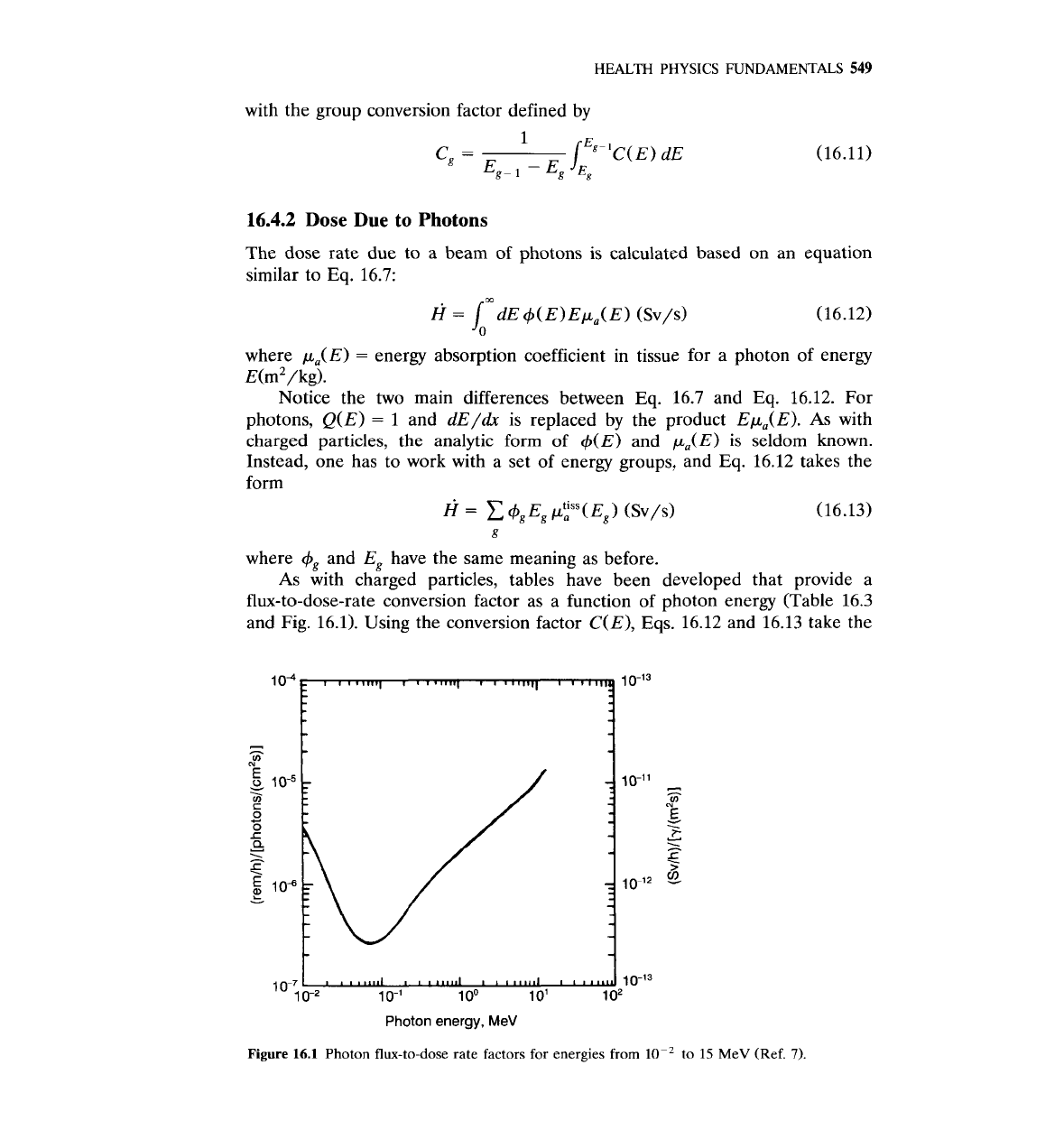
HEALTH
PHYSICS
FUNDAMENTALS
549
with the group conversion factor defined by
16.4.2
Dose Due to Photons
The dose rate due to a beam of photons is calculated based on an equation
similar to
Eq.
16.7:
where p,(E)
=
energy absorption coefficient in tissue for a photon of energy
E(m2/kg>.
Notice the two main differences between
Eq.
16.7 and
Eq.
16.12. For
photons, Q(E)
=
1
and dE/dx is replaced by the product Ep,(E). As with
charged particles, the analytic form of
+(E)
and
p,(E)
is seldom known.
Instead, one has to work with a set of energy groups, and
Eq.
16.12 takes the
form
H
=
z
+gEg
pZSS( E,) (SV/S)
(16.13)
g
where
4g
and
E,
have the same meaning as before.
As with charged particles, tables have been developed that provide a
flux-to-dose-rate conversion factor as a function of photon energy (Table 16.3
and Fig. 16.1). Using the conversion factor C(E), Eqs. 16.12 and 16.13 take the
B
.
t
.....I
t t
~nd
10-l3
.
.
.I
.
8 8
lo-;
0-2
lo-'
1
o0
10'
1
o2
Photon energy, MeV
Figure
16.1
Photon flux-to-dose rate factors for energies
from
lo-'
to
15
MeV (Ref.
7).
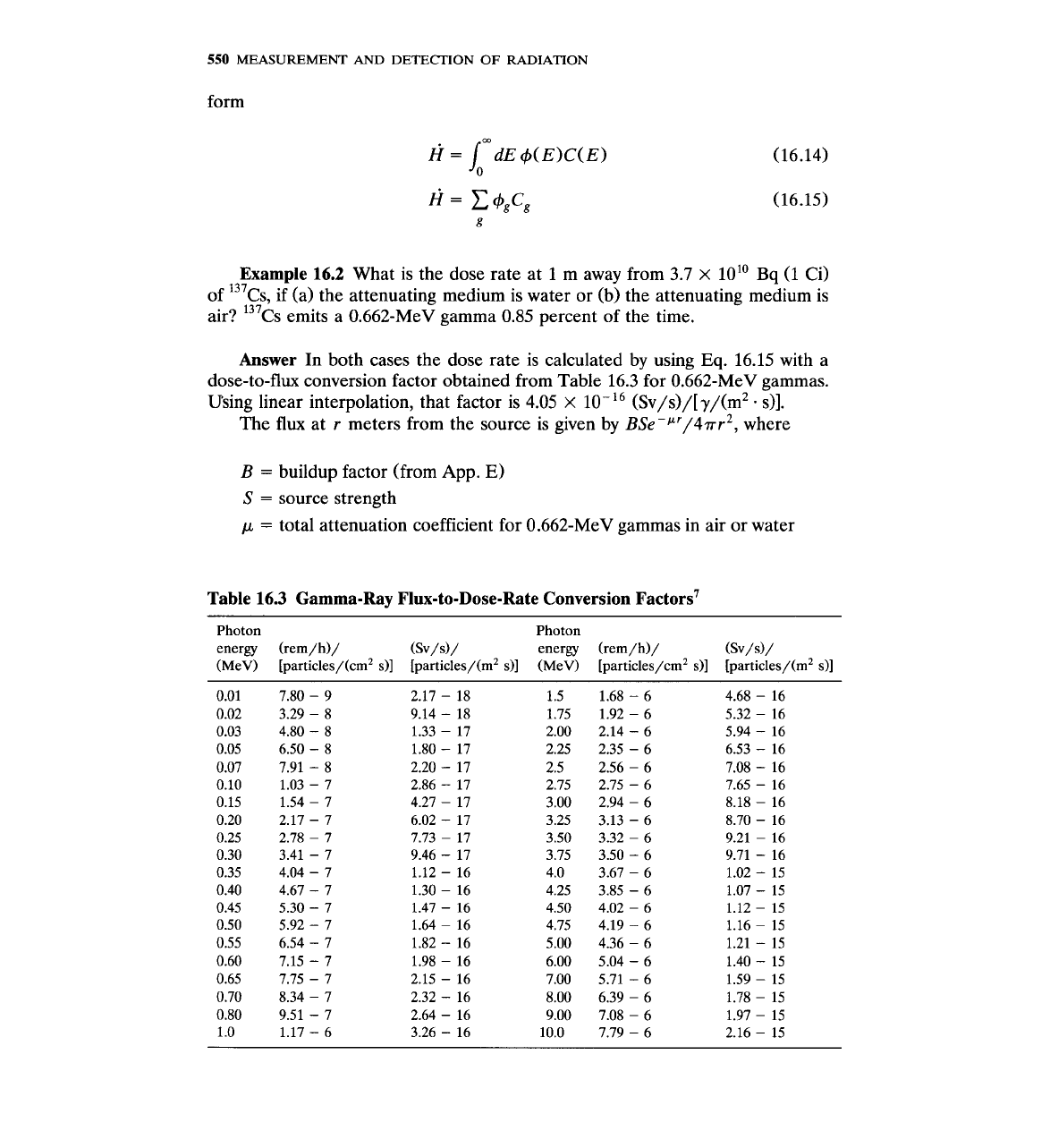
550
MEASUREMENT
AND
DETECTION
OF
RADIATION
form
Example 16.2
What is the dose rate at
1
m away from
3.7
x
10''
Bq
(1 Ci)
of 137~s, if (a) the attenuating medium is water or (b) the attenuating medium is
air?
'37~s emits a 0.662-MeV gamma 0.85 percent of the time.
Answer
In both cases the dose rate is calculated by using
Eq.
16.15 with a
dose-to-flux conversion factor obtained from
Table
16.3 for 0.662-MeV gammas.
Using linear interpolation, that factor is 4.05
X
10-l6 (Sv/s)/[y/(m2
.
$1.
The
flux
at r meters from the source is given by ~~e-~'/4.rrr~, where
B
=
buildup factor (from App.
E)
S
=
source strength
p
=
total attenuation coefficient for 0.662-MeV gammas in air or water
Table 16.3 Gamma-Ray Flux-to-Dose-Rate Conversion Factors7
Photon Photon
energy (rem/h)/ (SV/S)/ energy (rem/h)/ (SV/S)/
(MeV) [particles/(cm2 s)] [particles/(m2 s)] (MeV) [particles/cm2 s)] [particles/(m2 s)]
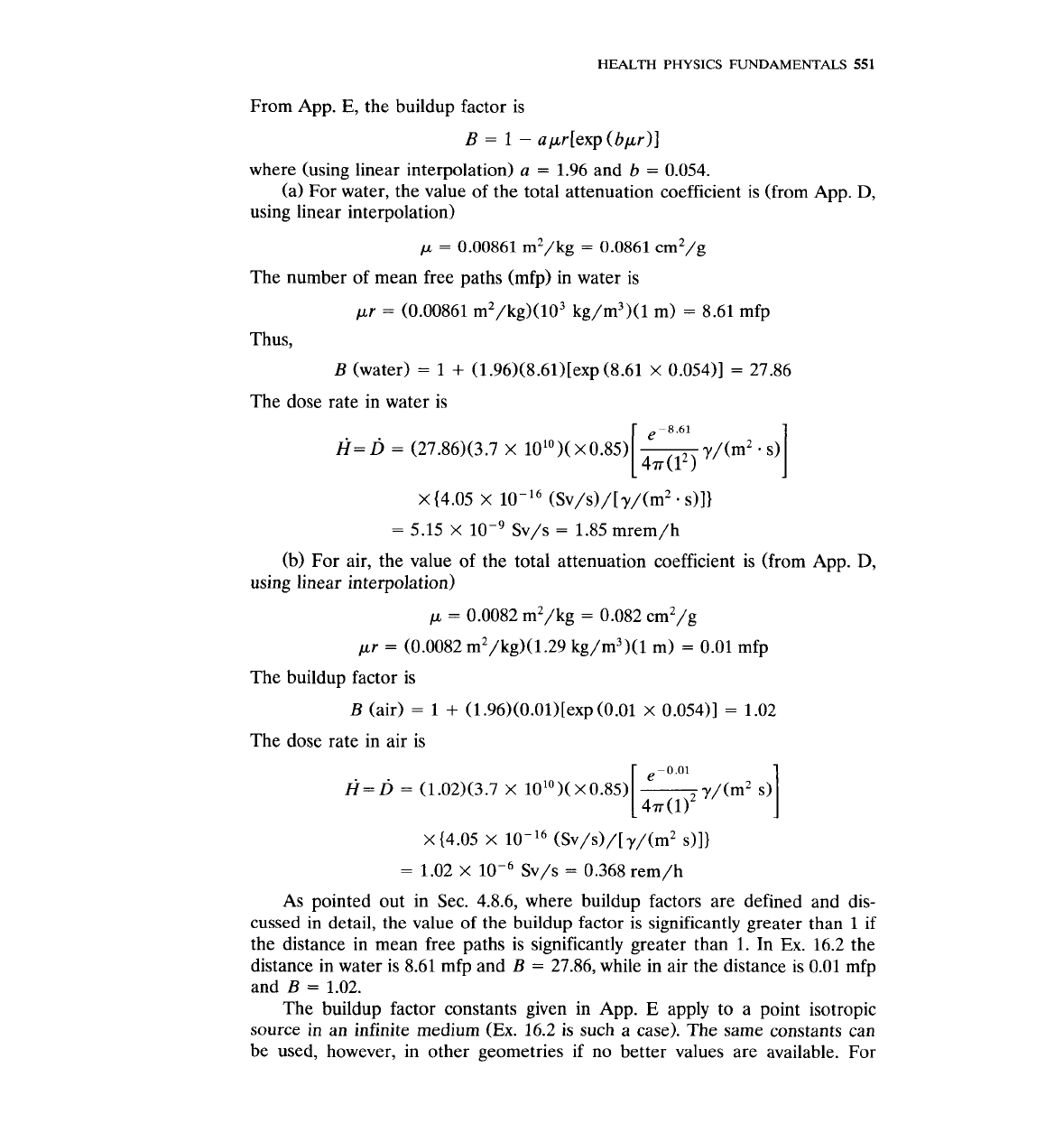
HEALTH
PHYSICS
FUNDAMENTALS
551
From App.
E,
the buildup factor is
where (using linear interpolation)
a
=
1.96 and
b
=
0.054.
(a) For water, the value of the total attenuation coefficient is (from App.
D,
using linear interpolation)
The number of mean free paths (mfp) in water is
pr
=
(0.00861 m2/kg)(103 kg/m3)(1 m)
=
8.61 mfp
Thus,
B
(water)
=
1
+
(1.96)(8.61)[exp(8.61
x
0.054)]
=
27.86
The dose rate in water is
(b) For air, the value of the total attenuation coefficient is (from App.
D,
using linear interpolation)
The buildup factor is
B
(air)
=
1
+
(1.96)(0.01)[exp (0.01
x
0.05411
=
1.02
The dose rate in air is
As pointed out in Sec. 4.8.6, where buildup factors are defined and dis-
cussed in detail, the value of the buildup factor is significantly greater than
1
if
the distance in mean free paths is significantly greater than
1.
In
Ex.
16.2 the
distance in water is 8.61 mfp and
B
=
27.86, while in air the distance is
0.01
mfp
and
B
=
1.02.
The buildup factor constants given in App.
E
apply to a point isotropic
source in an infinite medium
(Ex.
16.2 is such a case). The same constants can
be used, however, in other geometries if no better values are available. For
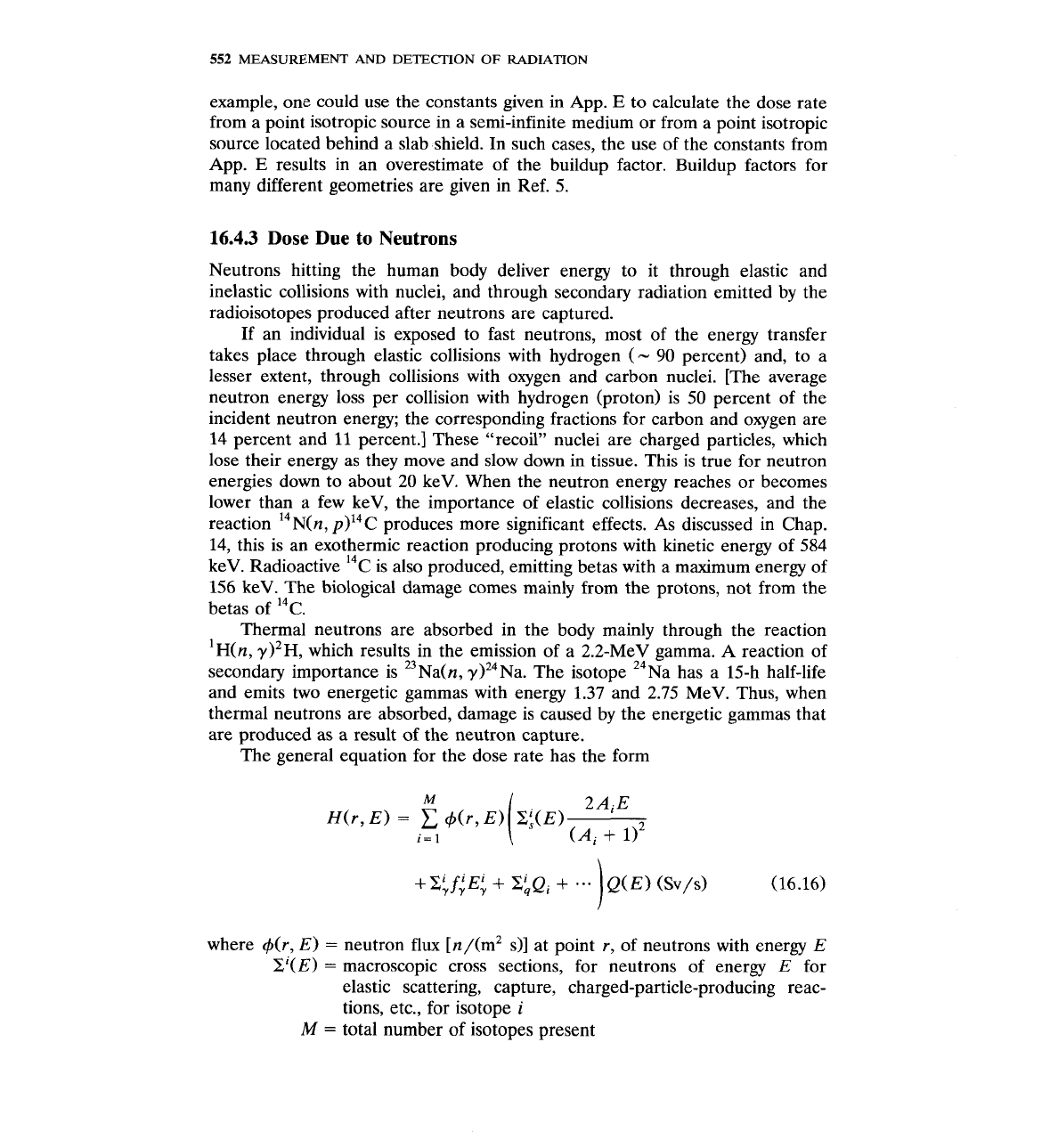
552
MEASUREMENT
AND
DETECTION
OF
RADIATION
example, one could use the constants given in App.
E
to calculate the dose rate
from a point isotropic source in a semi-infinite medium or from a point isotropic
source located behind a slab shield. In such cases, the use of the constants from
App.
E
results in an overestimate of the buildup factor. Buildup factors for
many different geometries are given in Ref.
5.
16.4.3
Dose Due to Neutrons
Neutrons hitting the human body deliver energy to it through elastic and
inelastic collisions with nuclei, and through secondary radiation emitted by the
radioisotopes produced after neutrons are captured.
If an individual is exposed to fast neutrons, most of the energy transfer
takes place through elastic collisions with hydrogen
(-
90 percent) and, to a
lesser extent, through collisions with oxygen and carbon nuclei. [The average
neutron energy loss per collision with hydrogen (proton) is 50 percent of the
incident neutron energy; the corresponding fractions for carbon and oxygen are
14 percent and
11
percent.] These "recoil" nuclei are charged particles, which
lose their energy as they move and slow down in tissue. This is true for neutron
energies down to about 20
keV. When the neutron energy reaches or becomes
lower than a few keV, the importance of elastic collisions decreases, and the
14
reaction
N(n, p)14C produces more significant effects. As discussed in Chap.
14, this is an exothermic reaction producing protons with kinetic energy of 584
keV. Radioactive
14c
is also produced, emitting betas with a maximum energy of
156 keV. The biological damage comes mainly from the protons, not from the
betas of
14c.
Thermal neutrons are absorbed in the body mainly through the reaction
'~(n, y)'~, which results in the emission of a 2.2-MeV gamma.
A
reaction of
secondary importance is 23~a(n, -yIz4~a. The isotope 24~a has a 15-h half-life
and emits two energetic gammas with energy 1.37 and 2.75 MeV. Thus, when
thermal neutrons are absorbed, damage is caused by the energetic gammas that
are produced as a result of the neutron capture.
The general equation for the dose rate has the form
where +(r, E)
=
neutron
flux
[n/(m2 s)] at point r, of neutrons with energy
E
Xi(E)
=
macroscopic cross sections, for neutrons of energy
E
for
elastic scattering, capture, charged-particle-producing reac-
tions, etc., for isotope
i
M
=
total number of isotopes present
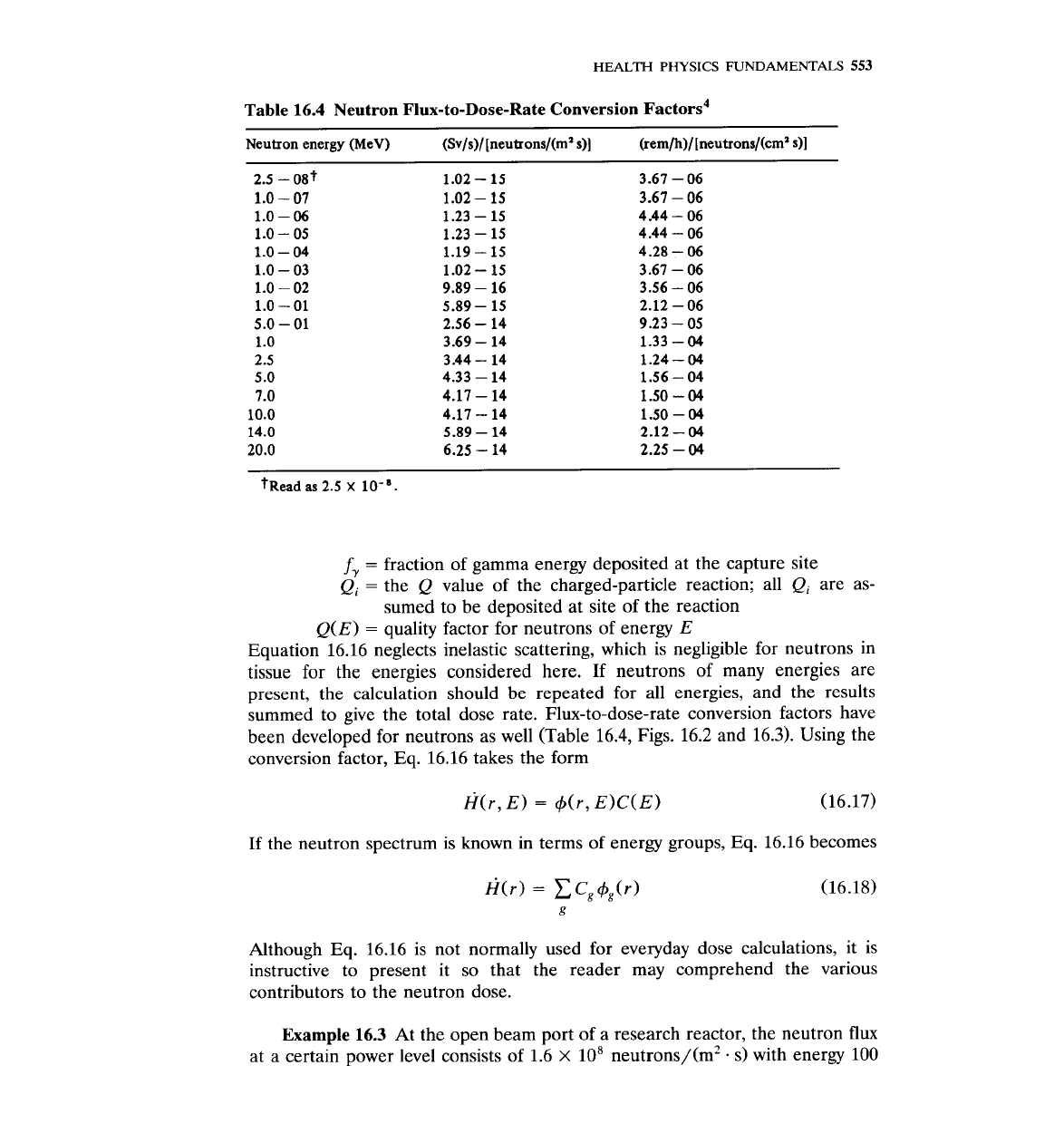
HEALTH
PHYSICS
FUNDAMENTALS
553
Table
16.4
Neutron Flux-to-Dose-Rate Conversion Factors4
Neutron energy
(MeV)
(Sv/s)/
[neut~ons/(m' s)] (remlh)/[neutrons/(cma s)]
2.5
-
087 1.02
-
15 3.67
-
06
1.0
-
07 1.02
-
15 3.67
-
06
1.0
-
06
1.23
-
15 4.44
-
06
1.0
-
05 1.23
-
15 4.44
-
06
1.0
-
04 1.19
-
15 4.28
-
06
1.0
-
03 1.02- 15 3.67
-
06
1.0
-
02 9.89
-
16 3.56
-
06
1.0
-
01 5.89
-
15 2.12
-
06
5.0
-
01 2.56
-
14
9.23
-
05
1.0 3.69
-
14 1.33
-
04
2.5 3.44
-
14 1.24-
04
5.0 4.33
-
14
1
.56
-
04
7.0 4.17
-
14 1.50
-
04
10.0 4.17
-
14 1.50
-
04
14.0 5.89
-
14 2.12
-
04
20.0 6.25
-
14 2.25
-
04
t~ead
as
2.5
X
lo-'.
f,
=
fraction of gamma energy deposited at the capture site
Qi
=
the Q value of the charged-particle reaction; all
Qi
are as-
sumed to be deposited at site of the reaction
Q(E)
=
quality factor for neutrons of energy E
Equation 16.16 neglects inelastic scattering, which is negligible for neutrons in
tissue for the energies considered here. If neutrons of many energies are
present, the calculation should be repeated for all energies, and the results
summed to give the total dose rate. Flux-to-dose-rate conversion factors have
been developed for neutrons as well (Table
16.4,
Figs.
16.2
and
16.3).
Using the
conversion factor,
Eq.
16.16 takes the form
If the neutron spectrum is known in terms of energy groups, Eq. 16.16 becomes
Although Eq. 16.16 is not normally used for everyday dose calculations, it is
instructive to present it so that the reader may comprehend the various
contributors to the neutron dose.
Example
16.3
At the open beam port of a research reactor, the neutron flux
at a certain power level consists of 1.6
x
lo8
neutrons/(m2
.
s) with energy 100

554
MEASUREMENT
AND DETECTION OF RADIATION
Figure
16.2
Neutron flux-to-1
rate factors for energies
10-
Neutron energy, MeV
MeV (Ref.
7).
dose-
-8
to
keV, and 3.5
X
lo9
neutrons/(m2 s) with an average energy
of
0.025 eV. What
is the total dose rate at that point?
Answer
Using Table 16.4, the dose rate is
H
=
(1.6
x
io8)(5.89
x
10-15)
+
(3.5
x
108)(1.02
x
10-15)
=
1.30
X
lop6
Sv/s
=
0.467 rem/h
Figure
16.3
Neutron flux-to-dose-rate factors for energies
to
20
MeV (Ref.
7).
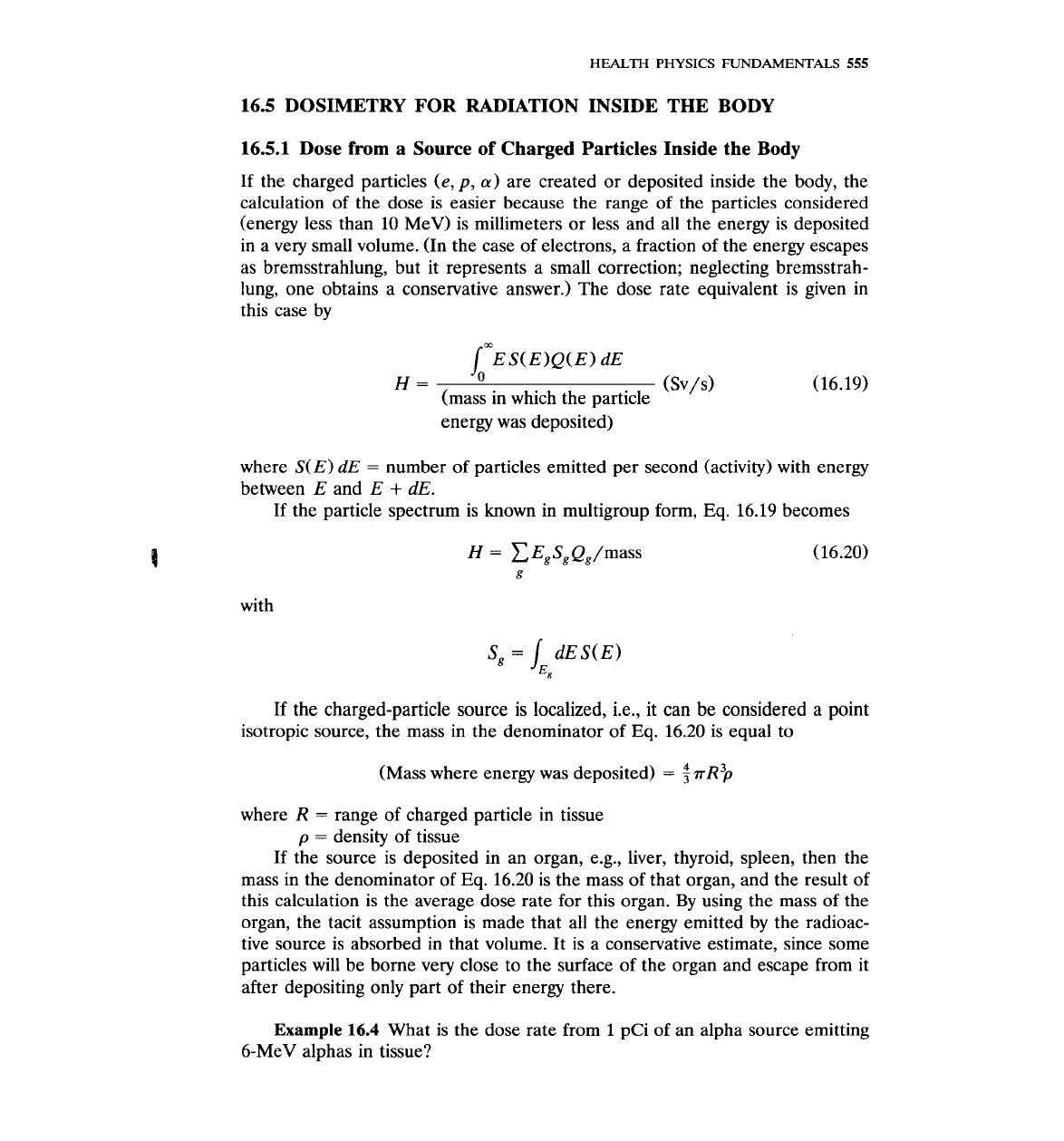
HEALTH
PHYSICS
FUNDAMENTALS
555
16.5 DOSIMETRY FOR RADIATION INSIDE THE BODY
16.5.1 Dose from a Source of Charged Particles Inside the Body
If the charged particles
(e,
p,
a)
are created or deposited inside the body, the
calculation of the dose is easier because the range of the particles considered
(energy less than 10 MeV) is millimeters or less and all the energy is deposited
in a very small volume. (In the case of electrons, a fraction of the energy escapes
as bremsstrahlung, but it represents a small correction; neglecting
bremsstrah-
lung, one obtains a conservative answer.) The dose rate equivalent is given in
this case by
im~
S(E)Q(E) d~
H=
(SV/S) (16.19)
(mass in which the particle
energy was deposited)
where S(E) dE
=
number of particles emitted per second (activity) with energy
between
E
and E
+
dE.
If the particle spectrum is known in multigroup form, Eq. 16.19 becomes
with
If the charged-particle source is localized,
i.e., it can be considered
a
point
isotropic source, the mass in the denominator of Eq. 16.20 is equal to
(Mass where energy was deposited)
=
;.rr~%
where
R
=
range of charged particle in tissue
p
=
density of tissue
If the source is deposited in an organ, e.g., liver, thyroid, spleen, then the
mass in the denominator of Eq. 16.20 is the mass of that organ, and the result of
this calculation is the average dose rate for this organ.
By
using the mass of the
organ, the tacit assumption is made that all the energy emitted by the radioac-
tive source is absorbed in that volume. It is a conservative estimate, since some
particles will be borne very close to the surface of the organ and escape from it
after depositing only part of their energy there.
Example
16.4
What is the dose rate from
1
pCi of an alpha source emitting
6-MeV alphas in tissue?
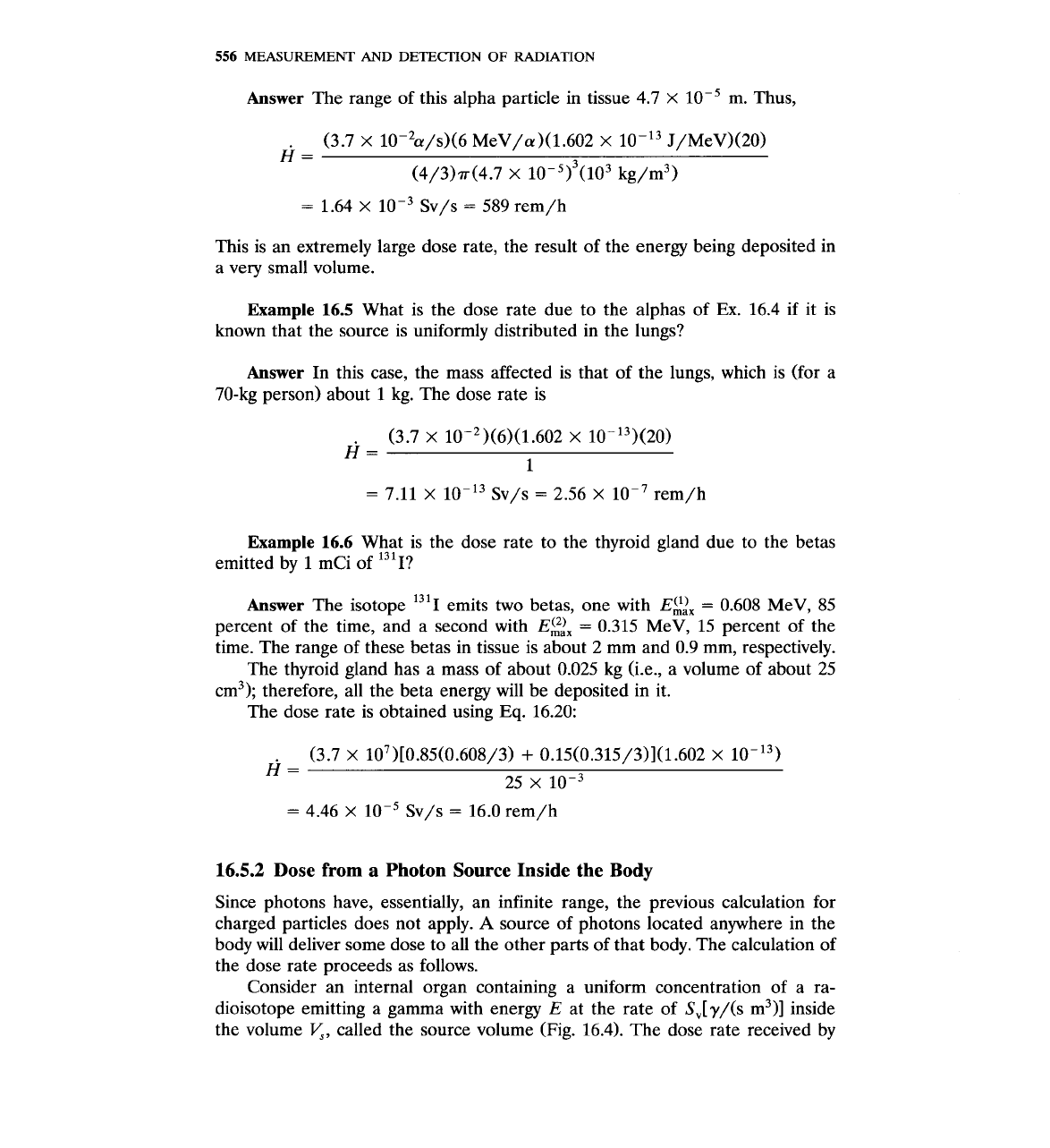
556
MEASUREMENT
AND DETECTION OF RADIATION
Answer
The range of this alpha particle in tissue 4.7
x
m. Thus,
This is an extremely large dose rate, the result of the energy being deposited in
a
very small volume.
Example
16.5
What is the dose rate due to the alphas of
Ex.
16.4 if it is
known that the source is uniformly distributed in the lungs?
Answer
In this case, the mass affected is that of the lungs, which is (for a
70-kg person) about
1
kg. The dose rate is
Example
16.6
What is the dose rate to the thyroid gland due to the betas
emitted by
1
mCi of l3'l?
Answer
The isotope 1311 emits two betas, one with
E:?,),
=
0.608 MeV, 85
percent of the time, and a second with
E:;,),
=
0.315 MeV, 15 percent of the
time. The range of these betas in tissue is about 2 mm and 0.9 mm, respectively.
The thyroid gland has a mass of about 0.025 kg (i-e., a volume of about 25
cm3); therefore, all the beta energy will be deposited in it.
The dose rate is obtained using
Eq.
16.20:
16.5.2
Dose from
a
Photon Source Inside the Body
Since photons have, essentially, an infinite range, the previous calculation for
charged particles does not apply.
A
source of photons located anywhere in the
body will deliver some dose to all the other parts of that body. The calculation of
the dose rate proceeds as follows.
Consider an internal organ containing a uniform concentration of a ra-
dioisotope emitting a gamma with energy
E
at the rate of S,[y/(s m3)] inside
the volume
V,,
called the source volume (Fig. 16.4). The dose rate received by
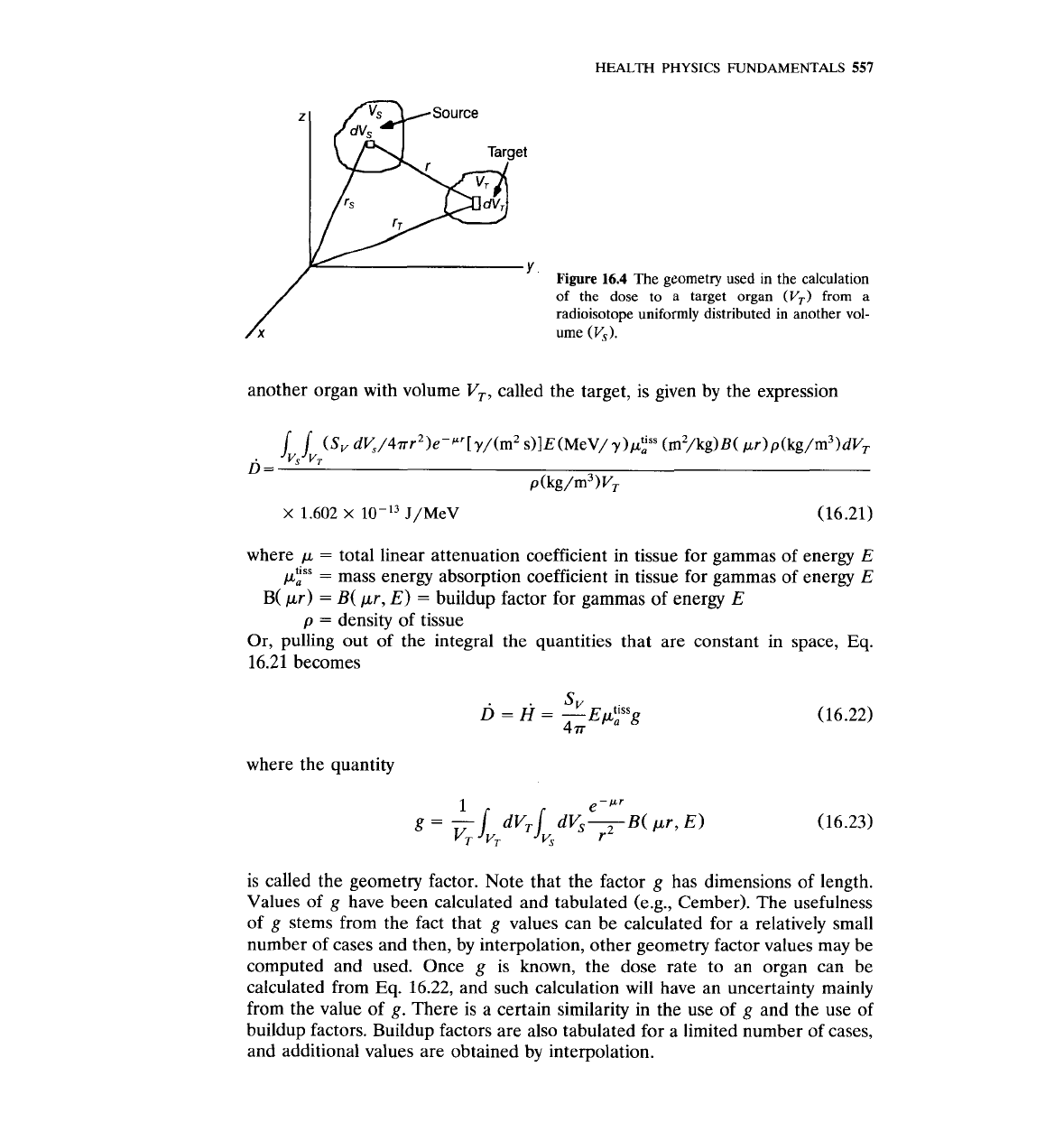
HEALTH
PHYSICS
FUNDAMENTALS
557
Figure
16.4
The geometry used in the calculation
of the dose to a target organ
(V,)
from
a
radioisotope uniformly distributed in another vol-
/X
ume
(vs).
another organ with volume VT, called the target, is given by the expression
where
p
=
total linear attenuation coefficient in tissue for gammas of energy
E
p$"
=
mass energy absorption coefficient in tissue for gammas of energy
E
B(
pr)
=
B(
pr, E)
=
buildup factor for gammas of energy E
p
=
density of tissue
Or, pulling out of the integral the quantities that are constant in space,
Eq.
16.21
becomes
where the quantity
1
e-~r
9
=
-/
~vTJ
dV,-B(
pr,
E)
VT
v
V,
r2
is called the geometry factor. Note that the factor
g
has dimensions of length.
Values of
g
have been calculated and tabulated (e.g., Cember). The usefulness
of
g
stems from the fact that
g
values can be calculated for a relatively small
number of cases and then, by interpolation, other geometry factor values may be
computed and used. Once
g
is known, the dose rate to an organ can be
calculated from Eq.
16.22,
and such calculation will have an uncertainty mainly
from the value of
g.
There is a certain similarity in the use of
g
and the use of
buildup factors. Buildup factors are also tabulated for a limited number of cases,
and additional values are obtained by interpolation.
